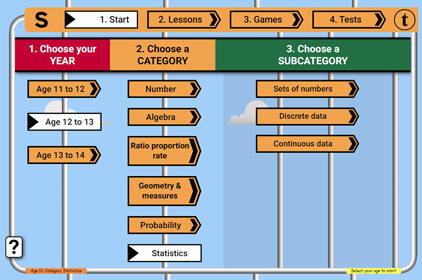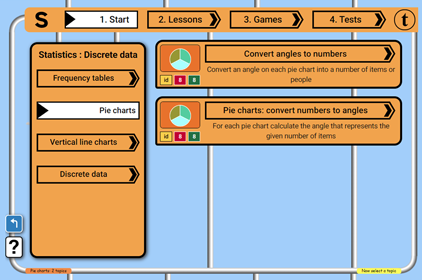


8th grade Probability topics for Secondary math learners
| Topic icon key | ||
eq | Equation | Each item in the topic is in the form of an equation |
id | Identify | Each item in the topic is a thing |
mi | Missing item | Each item in the topic is a statement with a missing term |
10 | Number of items | There are 10 items in this topic |
8 | Extended items | Additional questions for games and tests in this topic |
Our math topics for 8th grade learners are designed to follow closely the Common Core standards for math for 8th grade pupils.
Probability syllabus for 8th grade
Here are some key aspects of the math syllabus for probability for students aged 13 to 14:
Set Theory: Students are introduced to set theory as a foundation for probability. They learn about sets, subsets, union, intersection, and complement of sets. They use set notation and Venn diagrams to represent and analyze probability situations involving sets.
Conditional Probability and Independence: Students deepen their understanding of conditional probability and explore the concept of independence. They calculate conditional probabilities and determine whether events are independent or dependent. They apply these concepts to solve problems involving conditional probability and independence.
Probability Distributions: Students study probability distributions, including discrete and continuous distributions. They learn about probability mass functions (PMFs) and probability density functions (PDFs). They calculate measures such as mean, variance, and standard deviation for probability distributions.
Random Variables: Students explore random variables as a way to assign numerical values to outcomes in a probability experiment. They learn about discrete and continuous random variables and their probability distributions. They use random variables to calculate probabilities and expected values.
Sampling and Sampling Distributions: Students learn about sampling methods and sampling distributions. They explore the relationship between a population and a sample and understand how sample statistics can be used to make inferences about a population. They analyze sampling distributions and calculate probabilities related to sampling.
Hypothesis Testing: Students are introduced to the basic concepts of hypothesis testing. They learn about null and alternative hypotheses, Type I and Type II errors, and p-values. They apply hypothesis testing to make decisions and draw conclusions based on data.
Probability in Real-Life Applications: Students apply probability concepts to real-life applications and decision-making scenarios. They analyze and interpret data, calculate probabilities, and make predictions in contexts such as genetics, finance, sports, and risk assessment. They evaluate the reliability of probabilistic information in various contexts.
Critical Thinking and Problem-Solving: Students engage in critical thinking activities, complex problem-solving, and mathematical modeling. They analyze and evaluate real-world situations, make informed decisions, and communicate their reasoning using appropriate mathematical language and notation.
Throughout the syllabus, students engage in hands-on activities, simulations, and real-world applications to reinforce their understanding of probability. They develop their skills in data analysis, critical thinking, logical reasoning, statistical inference, and mathematical communication.
A topic is selected at the beginning of a session at Free Math Games and will be remembered when you move between games or activities. The math for the topic is carefully constructed to match the level of difficulty taught in US schools. This means that you as a secondary pupil should see similar math problems to those you are seeing at school (if you are at school) for any particular subject. Please let us know if that is not the case.
See the help box below for instructions on choosing a topic here at Free Math Games.
UXO * Duck shoot * The frog flies * Pong * Cat and mouse * The beetle and the bee
Rock fall * Four in a row * Sow grow * Choose or lose * Mix and match





How to choose a 8th grade Probability topic for Secondary math

Click on the "1. Start" button in the top navigation bar - that brings you to this Secondary level topic selection page. On the topic selection page you will see that the topics are divided up:
- By level (Preschool, Elementary and Secondary)
- By grade (6th to 8th for this level)
- Into broad categories
Since you are currently within the Secondary section of Free Math Games you will see the Secondary topics. The Secondary grades will have loaded. Choose your grade. The broad categories available will load. Click on a category to see the available sub-categories and topics.

For example, if you choose 7th grade, then the category: "Algebra" and the sub-category "Sequences" you will be offered a choice of sub-sub-categories and topics suitable for your school grade - in the case of this example, "Generating terms" and "nth term expressions". Click on each sub-sub-category to view the available topics.
When you click on the name of a topic, the topic will load into the lesson page (once a topic has loaded it will be available for all activities and will not have to be downloaded again) and the lesson start page will be displayed. You can choose to do the lesson or jump immediately to the games using that topic.










